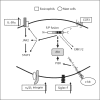FIP1L1/PDGFR alpha-associated systemic mastocytosis
- PMID: 20523072
- PMCID: PMC2917731
- DOI: 10.1159/000312134
FIP1L1/PDGFR alpha-associated systemic mastocytosis
Abstract
Since the identification of the FIP1L1/PDGFRA fusion gene as a pathogenic cause of the hypereosinophilic syndrome (HES), the importance of the molecular classification of HES leading to the diagnosis of chronic eosinophilic leukemia (CEL) has been recognized. As a result, a new category, 'myeloid and lymphoid neoplasm with eosinophilia and abnormalities in PDGFRA, PDGFRB or FGFR1', has recently been added to the new WHO criteria for myeloid neoplasms. FIP1L1/PDGFR alpha-positive disorders are characterized by clonal hypereosinophilia, multiple organ dysfunctions due to eosinophil infiltration, systemic mastocytosis (SM) and a dramatic response to treatment with imatinib mesylate. A murine HES/CEL model by the introduction of FIP1L1/PDGFR alpha and IL-5 overexpression also shows SM, representing patients with FIP1L1/PDGFR alpha-positive HES/CEL/SM. The murine model and the in vitro development system of FIP1L1/PDGFR alpha-positive mast cells revealed the interaction between FIP1L1/PDGFR alpha, IL-5 and stem cell factor in the development of HES/CEL/SM. Current findings of FIP1L1/PDGFR alpha-positive HES/CEL are reviewed focusing on aberrant mast cell development leading to SM.
(c) 2010 S. Karger AG, Basel.
Figures


Similar articles
-
CHIC2 deletion, a surrogate for FIP1L1-PDGFRA fusion, occurs in systemic mastocytosis associated with eosinophilia and predicts response to imatinib mesylate therapy.Blood. 2003 Nov 1;102(9):3093-6. doi: 10.1182/blood-2003-05-1627. Epub 2003 Jul 3. Blood. 2003. PMID: 12842979
-
Systemic mastocytosis (SM) associated with chronic eosinophilic leukemia (SM-CEL): detection of FIP1L1/PDGFRalpha, classification by WHO criteria, and response to therapy with imatinib.Leuk Res. 2006 Sep;30(9):1201-5. doi: 10.1016/j.leukres.2005.11.014. Epub 2006 Jan 6. Leuk Res. 2006. PMID: 16406018
-
KIT D816V-associated systemic mastocytosis with eosinophilia and FIP1L1/PDGFRA-associated chronic eosinophilic leukemia are distinct entities.J Allergy Clin Immunol. 2007 Sep;120(3):680-7. doi: 10.1016/j.jaci.2007.05.024. Epub 2007 Jul 12. J Allergy Clin Immunol. 2007. PMID: 17628645
-
Eosinophilia in mast cell disease.Immunol Allergy Clin North Am. 2014 May;34(2):357-64. doi: 10.1016/j.iac.2014.01.013. Epub 2014 Mar 13. Immunol Allergy Clin North Am. 2014. PMID: 24745679 Free PMC article. Review.
-
FIP1L1-PDGFR alpha, a therapeutic target for the treatment of chronic eosinophilic leukemia.Verh K Acad Geneeskd Belg. 2005;67(3):169-76. Verh K Acad Geneeskd Belg. 2005. PMID: 16089297 Review.
Cited by
-
A 26-Year-Old Female with Systemic Mastocytosis with Associated Myeloid Neoplasm with Eosinophilia and Abnormalities of PDGFRB, t(4;5)(q21;q33).Case Rep Hematol. 2016;2016:4158567. doi: 10.1155/2016/4158567. Epub 2016 Aug 25. Case Rep Hematol. 2016. PMID: 27648315 Free PMC article.
-
KIT D816V Positive Acute Mast Cell Leukemia Associated with Normal Karyotype Acute Myeloid Leukemia.Case Rep Hematol. 2018 Feb 18;2018:3890361. doi: 10.1155/2018/3890361. eCollection 2018. Case Rep Hematol. 2018. PMID: 29670776 Free PMC article.
-
STAT5 acetylation: Mechanisms and consequences for immunological control and leukemogenesis.JAKSTAT. 2013 Oct 1;2(4):e26102. doi: 10.4161/jkst.26102. Epub 2013 Aug 19. JAKSTAT. 2013. PMID: 24416653 Free PMC article. Review.
-
[Treatment of adult acute lymphoblastie leukemia with eosinophilia and abnormality of PDGFRA by autologous hematopoietic stem cell transplantation and imatinib: one case report and literatures review].Zhonghua Xue Ye Xue Za Zhi. 2015 Oct;36(10):866-7. doi: 10.3760/cma.j.issn.0253-2727.2015.10.013. Zhonghua Xue Ye Xue Za Zhi. 2015. PMID: 26477768 Free PMC article. Review. Chinese. No abstract available.
-
Lyn mediates FIP1L1-PDGFRA signal pathway facilitating IL-5RA intracellular signal through FIP1L1-PDGFRA/JAK2/Lyn/Akt network complex in CEL.Oncotarget. 2016 Aug 19;8(39):64984-64998. doi: 10.18632/oncotarget.11401. eCollection 2017 Sep 12. Oncotarget. 2016. PMID: 29029406 Free PMC article.
References
-
- Cools J, DeAngelo DJ, Gotlib J, Stover EH, Legare RD, Cortes J, Kutok J, Clark J, Galinsky I, Griffin JD, Cross NC, Tefferi A, Malone J, Alam R, Schrier SL, Schmid J, Rose M, Vandenberghe P, Verhoef G, Boogaerts M, Wlodarska I, Kantarjian H, Marynen P, Coutre SE, Stone R, Gilliland DG. A tyrosine kinase created by fusion of the PDGFRA and FIP1L1 genes as a therapeutic target of imatinib in idiopathic hypereosinophilic syndrome. N Engl J Med. 2003;348:1201–1214. - PubMed
-
- Curtis CE, Grand FH, Musto P, Clark A, Murphy J, Perla G, Minervini MM, Stewart J, Reiter A, Cross NC. Two novel imatinib-responsive PDGFRA fusion genes in chronic eosinophilic leukaemia. Br J Haematol. 2007;138:77–81. - PubMed
-
- Score J, Curtis C, Waghorn K, Stalder M, Jotterand M, Grand FH, Cross NC. Identification of a novel imatinib-responsive KIF5B-PDGFRA fusion gene following screening for PDGFRA overexpression in patients with hypereosinophilia. Leukemia. 2006;20:827–832. - PubMed
-
- Walz C, Curtis C, Schnittger S, Schultheis B, Metzgeroth G, Schoch C, Lengfelder E, Erben P, Muller MC, Haferlach T, Hochhaus A, Hehlmann R, Cross NC, Reiter A. Transient response to imatinib in a chronic eosinophilic leukemia associated with ins(9;4)(q33;q12q25) and a CDK5RAP2-PDGFRA fusion gene. Genes Chromosomes Cancer. 2006;45:950–956. - PubMed
-
- Tefferi A, Vardiman JW. Classification and diagnosis of myeloproliferative neoplasms: the 2008 World Health Organization criteria and point-of-care diagnostic algorithms. Leukemia. 2008;22:14–22. - PubMed
Publication types
MeSH terms
Substances
Grants and funding
LinkOut - more resources
Full Text Sources
Research Materials
Miscellaneous

